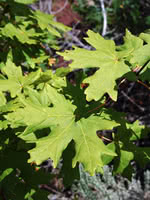Mon-Fri 9am - 5pm Mountain time
Common Hackberry vs Big Tooth Maple
Celtis occidentalis
Acer grandidentatum
NOT AVAILABLE THIS SEASON - MIGHT RETURN
The Common Hackberry is a medium-sized deciduous tree that resembles the American Elm but is immune to Dutch Elm Disease. They are versatile and can adapt to a variety of growing conditions.
It produces purple-red, berry-like fruit with a large seed in the center. Both the sweet flesh, which tastes similar to dates, and the crunchy seed are edible. The fruit remains on the tree throughout the winter, offering a valuable food source for birds and other wildlife.
The Common Hackberry can also be a great addition to a pollinator garden. The tree itself is a host for the larvae of several butterfly species and the flowers provide a source of pollen and nectar.
Big Tooth Maple is a versatile, cold hardy maple variety that is ideal for small landscapes. It has high ornamental appeal due to its striking red-gold autumn foliage and multi-stemmed form.
Big Tooth Maple is highly deer resistant and drought tolerant as well. Keep in mind the size and form of this tree can vary due to climate, moisture, and growing conditions. In drier spots, you'll notice Big Tooth Maple is more shrub like. In moist, full sun conditions, this tree can grow to be up to 50 ft tall. Plan your site accordingly.

